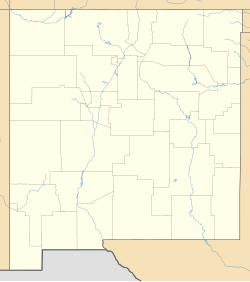Elephant Butte Lake State Park
| Elephant Butte Lake State Park | |
|---|---|
 Elephant Butte Reservoir from Elephant Butte Lake State Park, April 2011 | |
| Location | Sierra County, New Mexico, United States |
| Coordinates | 33°15′0″N 107°10′0″W / 33.25000°N 107.16667°W |
| Area | 24,500 acres (99 km2) |
| Elevation | 4,500 ft (1,400 m) |
| Established | 1964 |
| Governing body | New Mexico State Parks Division |
Elephant Butte Lake State Park is a state park of New Mexico, United States, located 7 miles (11 km) north of Truth or Consequences along the shore of Elephant Butte Reservoir in Sierra County.
Description
[edit]The park is the largest state park in New Mexico and surrounds the state's largest reservoir.[1] The 36,000-acre (150 km2) reservoir, created in 1916 across the Rio Grande, is 40 miles (64 km) long with more than 200 miles (320 km) of shoreline.
Elephant Butte Dam is named after a rock formation resembling an elephant.[2] Crews began construction on the dam in 1911 and ended in 1916. This was a major engineering feat in its day. The enormous concrete dam is the major feature of the Elephant Butte National Register Historic District. New Mexico State Parks operates a visitor center that contains information on the construction of the dam.[3] There are 3 developed camps on the lake, with over 200 camping and picnicking sites, concession-operated marinas, and stores. Recreation at Elephant Butte Reservoir is managed by the New Mexico State Parks under agreement with the United States Bureau of Reclamation.
An stegomastodon fossil was discovered there on June 9, 2014.[4][5] The dam serves as a way to ease flooding, control irrigation and provide electricity.[2] Talk of a dam began in the 1880s after farmers in southern New Mexico, Texas and Mexico began to complain that they were not receiving their fair share of water.[2] A legal battle over the water and where the dam should be built delayed its construction.[2] The dam would get a few more names before the elephant took up permanent residence.[2]
In the late 1800s, local newspapers were already referring to the area where the dam would eventually be built as Elephant Butte.[2] Upper Town was designated for what was considered the higher class and more skilled workers, including engineers and supervisors.[6] There was further segregation with Mexicans and Americans separated into different areas.[2]
See also
[edit]References
[edit]- ^ Recreation.gov. "Elephant Butte Reservoir".
- ^ a b c d e f g "Elephant Butte looks the part, but a long, storied history is at the center of how the dam got and kept its name - Albuquerque Journal". www.abqjournal.com. July 5, 2020. Retrieved May 2, 2022.
- ^ Pittock, Drew (March 29, 2024). "Elephant Butte Lake State Park launches $1 million upgrade to elevate visitor experience". KFOX. Retrieved April 2, 2024.
- ^ "Scientist: Elephant Butte stegomastodon discovery 'most complete elephant skull of any kind'". Archived from the original on June 16, 2014. Retrieved June 16, 2014.
- ^ New Mexico bachelor party finds 3-million-year-old stegomastodon fossil, Fox News, June 13, 2014 from foxnews.com, accessed December 27, 2016
- ^ Briseno, Elaine (July 5, 2020). "Elephant Butte looks the part, but a long, storied history is at the center of how the dam got and kept its name". Albuquerque Journal. Retrieved May 2, 2022.
